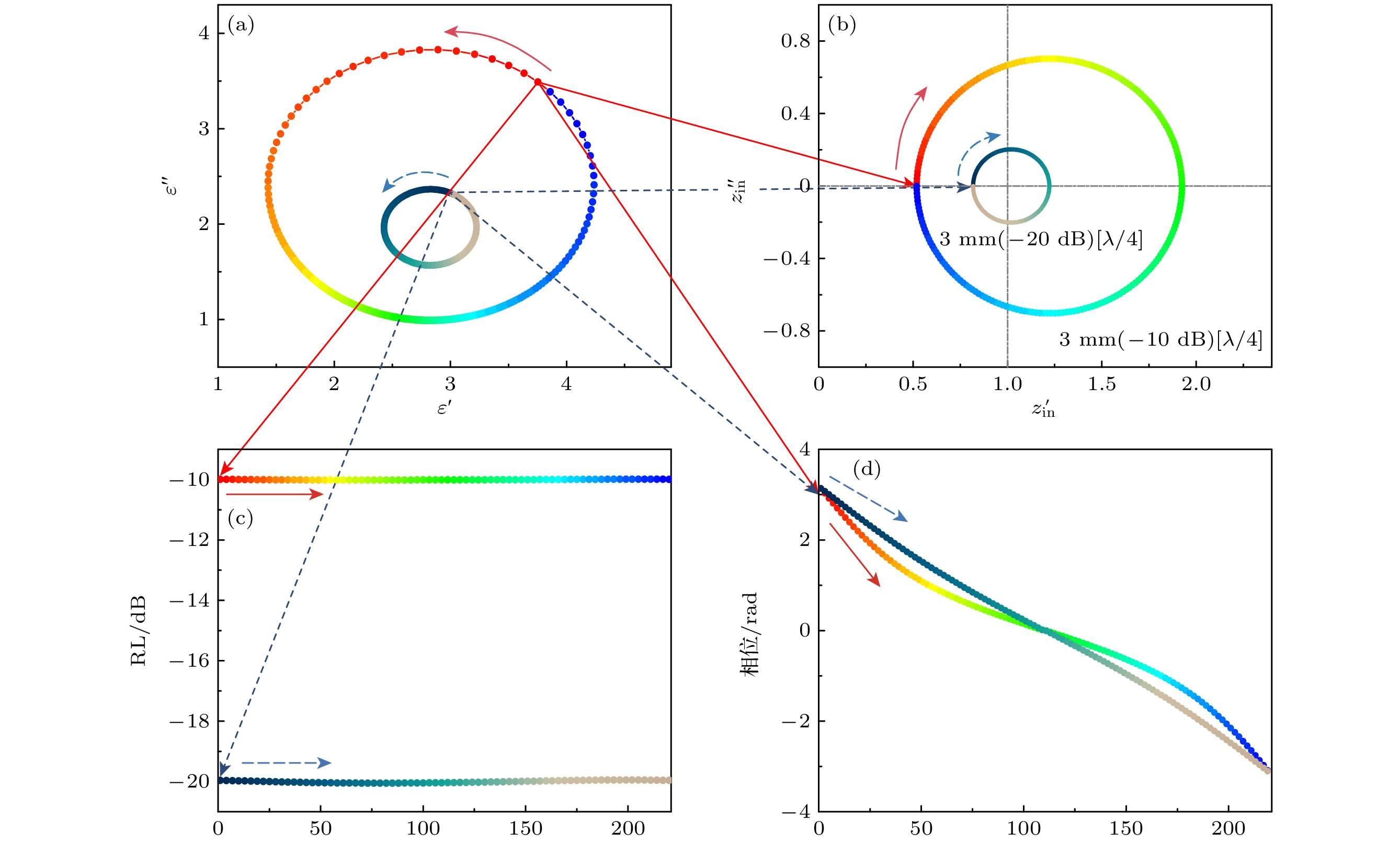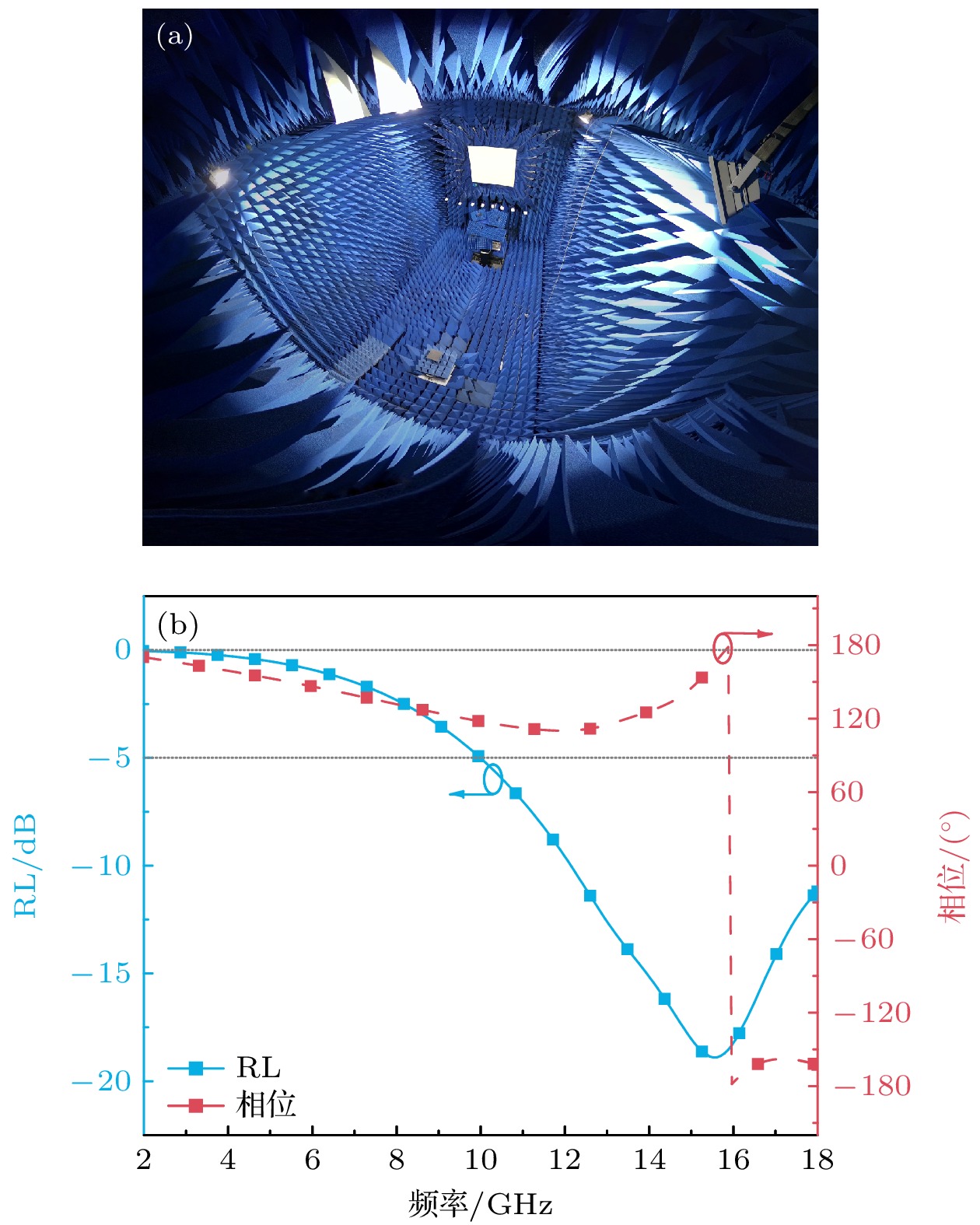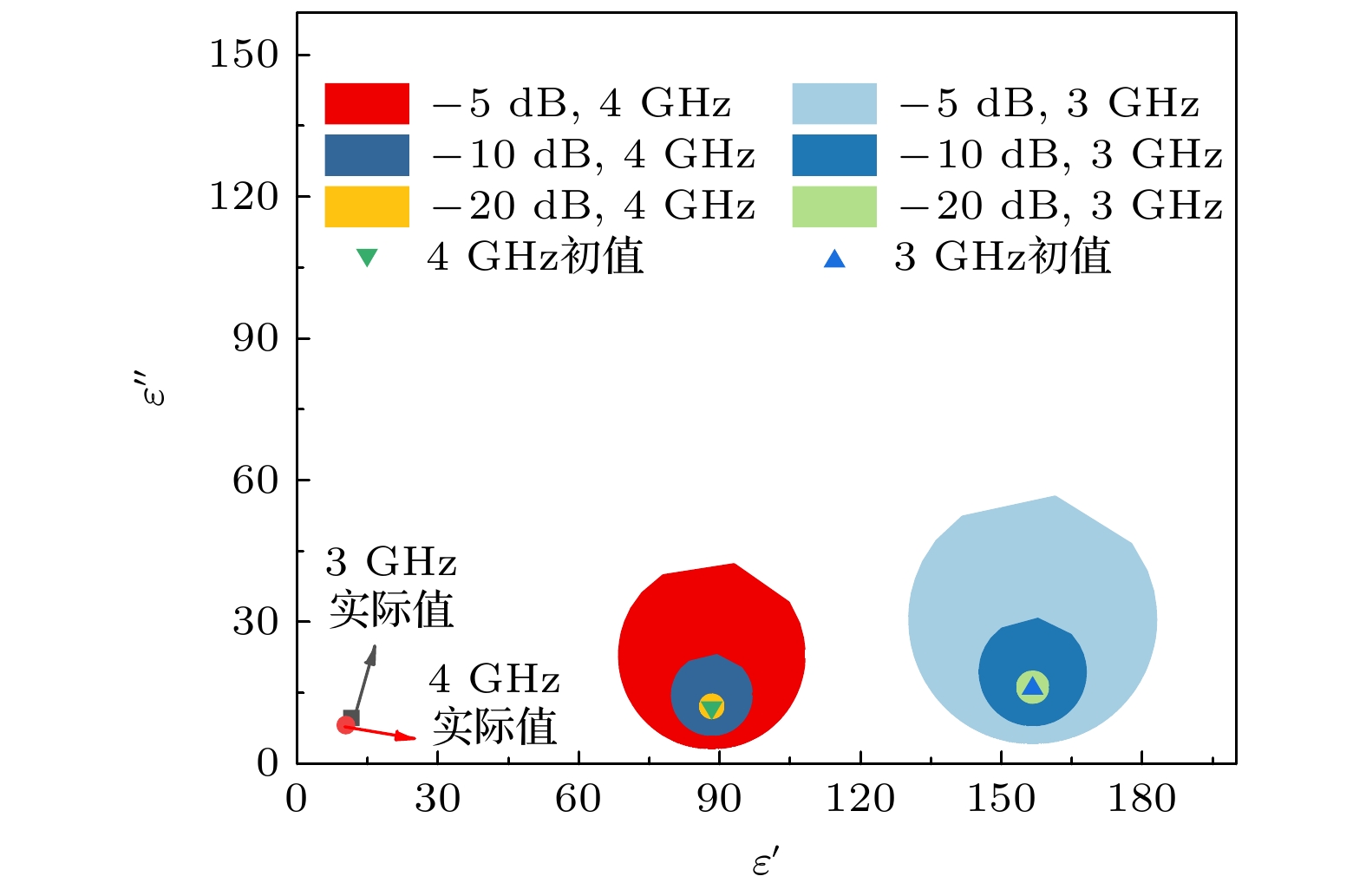-
Complex permittivity is an important parameter to reflect the macroscopic electromagnetic properties of material. The selection, design, and application of related materials and devices in the electromagnetic field must be based on the electromagnetic parameters of materials in the working frequency band. The numerical iterative method is an important method to inverse and calculate the complex permittivity of material. But there always exists a difficult problem that the initial value of iteration is difficult to give accurately. Based on the relationship between the complex permittivity and the reflectivity of absorbing material, an initial value selecting method for iteration to invert permittivity of absorbing material is proposed in this work. For absorbing materials with arbitrary thickness at a certain frequency, the complex permittivity must be near the complex permittivity of perfect matching layer. Therefore, the permittivity of perfect matching layer can be used as the initial value of the iterative algorithm. On this basis, a method of calculating the complex permittivity of monolayer absorbing material by using the reflection parameter is constructed. The experimental results show that the complex permittivity of lossy material can be calculated more accurately at the frequency with absorbing performance. However a great error can be caused at the frequency where the reflectivity is close to zero. Based on the iterative solution of the complex permittivity of single-layer absorbing material, a new method of measuring the complex permittivity of material is constructed by combining multi-layer absorbing materials to enhance full-band reflectivity. Given the electromagnetic parameters of other layer materials , the permittivity of absorbing materials and low-loss materials can be obtained accurately.
-
Keywords:
- absorbing materials /
- reflectivity /
- complex permittivity /
- S- parameters inversion
[1] Zoughi R 2000 Microwave Non-destructive Testing and Evaluation Principles (Vol. 4) (Dordrecht: Springer Science & Business Media) pp12–13
[2] Chen L F, Ong C K, Neo C, Varadan V V, Varadan V K 2004 Microwave Electronics: Measurement and Materials Characterization (Vol. 1) (West Sussex: John Wiley & Sons) pp2–6
[3] Weir W B 1974 Proc. IEEE 62 33
 Google Scholar
Google Scholar
[4] Lau I, Frank M, Shi K, Lurz F, Talai A, Weigel R, Koelpin A 2018 2018 48 th European Microwave Conference (EuMC) Madrid, September 23–27, 2018 pp202–205
[5] Houtz D A, Gu D, Walker D K 2016 IEEE Trans. Microw. Theory Tech. 64 3820
 Google Scholar
Google Scholar
[6] Hasar U C 2017 IEEE Trans. Microw. Theory Tech. 66 1090
[7] Hasar U C 2009 Prog. Electromagn. Res. 95 365
 Google Scholar
Google Scholar
[8] Cuong H M, Duc N T, Van Yem V 2017 2017 International Conference on Advanced Technologies for Communications (ATC) Quy Nhon, October 18–20, 2017 pp156–160
[9] 田步宁, 杨德顺, 唐家明, 刘其中 2001 电波科学学报 16 57
 Google Scholar
Google Scholar
Tian B L, Yang D S, Tang J M, Liu Q Z 2001 Chin. J. Radio 16 57
 Google Scholar
Google Scholar
[10] Li Q, Chen Y, Caisse C, Horn A, Harris V G 2020 IEEE Trans. Microw. Theory Tech. 68 4940
 Google Scholar
Google Scholar
[11] 丁世敬, 黄刘宏, 李跃波, 薛凡喜 2012 物理学报 61 220601
 Google Scholar
Google Scholar
Ding S J, Huang L H, Li Y B, Xue F X 2012 Acta Phys. Sin. 61 220601
 Google Scholar
Google Scholar
[12] Qi Y, Bai Y, Mi B 2016 Progress in Electromagnetic Research Symposium (PIERS) Shanghai, China, August 8–11, 2016 pp4583–4586
[13] Baker-Jarvis J, Vanzura E J, Kissick W A 1990 IEEE Trans. Microw. Theory Tech. 38 1096
 Google Scholar
Google Scholar
[14] Baker-Jarvis J, Geyer R G, Domich P D 1992 IEEE Trans. Instrum. Meas. 41 646
 Google Scholar
Google Scholar
[15] Guo G, Li E, Li Z, Zhang Q, He F 2011 Meas. Sci. Technol. 22 045707
 Google Scholar
Google Scholar
[16] Pozar D M 2011 Microwave Engineering (Vol. 4) (Hoboken: John Wiley & Sons) pp57–58
[17] Rozanov K N, Koledintseva M Y 2017 Procedia Eng. 216 79
 Google Scholar
Google Scholar
[18] Li D, Li Y, Wang X, Yang J, Chen F, Luo H, Nie Y, Gong R 2021 J. Electromagnet. Wave 35 801
 Google Scholar
Google Scholar
[19] Zhou Q, Yin X, Ye F, Mo R, Liu X, Fan X, Cheng L, Zhang L 2018 J. Am. Ceram. Soc. 101 5552
 Google Scholar
Google Scholar
[20] 刘海韬, 黄文质, 周永江 2017 高温吸波结构材料 (第1版) (北京: 科学出版社) 第109页
Liu H T, Huang W Z, Zhou Y J 2017 High-Temperature Structural Materials for Microwave Absorption (Vol. 1) (Beijing: Science Press) p109 (in Chinese)
[21] Wang C, Li J, Guo S 2019 Compos. Part A: Appl. S. 125 105522
 Google Scholar
Google Scholar
[22] Zhou Q, Yin X, Xu H, Li M, Fan X, Yu Z, Ye F, Cheng L, Zhang L 2019 J. Phys. D: Appl. Phys. 52 435102
 Google Scholar
Google Scholar
-
-
[1] Zoughi R 2000 Microwave Non-destructive Testing and Evaluation Principles (Vol. 4) (Dordrecht: Springer Science & Business Media) pp12–13
[2] Chen L F, Ong C K, Neo C, Varadan V V, Varadan V K 2004 Microwave Electronics: Measurement and Materials Characterization (Vol. 1) (West Sussex: John Wiley & Sons) pp2–6
[3] Weir W B 1974 Proc. IEEE 62 33
 Google Scholar
Google Scholar
[4] Lau I, Frank M, Shi K, Lurz F, Talai A, Weigel R, Koelpin A 2018 2018 48 th European Microwave Conference (EuMC) Madrid, September 23–27, 2018 pp202–205
[5] Houtz D A, Gu D, Walker D K 2016 IEEE Trans. Microw. Theory Tech. 64 3820
 Google Scholar
Google Scholar
[6] Hasar U C 2017 IEEE Trans. Microw. Theory Tech. 66 1090
[7] Hasar U C 2009 Prog. Electromagn. Res. 95 365
 Google Scholar
Google Scholar
[8] Cuong H M, Duc N T, Van Yem V 2017 2017 International Conference on Advanced Technologies for Communications (ATC) Quy Nhon, October 18–20, 2017 pp156–160
[9] 田步宁, 杨德顺, 唐家明, 刘其中 2001 电波科学学报 16 57
 Google Scholar
Google Scholar
Tian B L, Yang D S, Tang J M, Liu Q Z 2001 Chin. J. Radio 16 57
 Google Scholar
Google Scholar
[10] Li Q, Chen Y, Caisse C, Horn A, Harris V G 2020 IEEE Trans. Microw. Theory Tech. 68 4940
 Google Scholar
Google Scholar
[11] 丁世敬, 黄刘宏, 李跃波, 薛凡喜 2012 物理学报 61 220601
 Google Scholar
Google Scholar
Ding S J, Huang L H, Li Y B, Xue F X 2012 Acta Phys. Sin. 61 220601
 Google Scholar
Google Scholar
[12] Qi Y, Bai Y, Mi B 2016 Progress in Electromagnetic Research Symposium (PIERS) Shanghai, China, August 8–11, 2016 pp4583–4586
[13] Baker-Jarvis J, Vanzura E J, Kissick W A 1990 IEEE Trans. Microw. Theory Tech. 38 1096
 Google Scholar
Google Scholar
[14] Baker-Jarvis J, Geyer R G, Domich P D 1992 IEEE Trans. Instrum. Meas. 41 646
 Google Scholar
Google Scholar
[15] Guo G, Li E, Li Z, Zhang Q, He F 2011 Meas. Sci. Technol. 22 045707
 Google Scholar
Google Scholar
[16] Pozar D M 2011 Microwave Engineering (Vol. 4) (Hoboken: John Wiley & Sons) pp57–58
[17] Rozanov K N, Koledintseva M Y 2017 Procedia Eng. 216 79
 Google Scholar
Google Scholar
[18] Li D, Li Y, Wang X, Yang J, Chen F, Luo H, Nie Y, Gong R 2021 J. Electromagnet. Wave 35 801
 Google Scholar
Google Scholar
[19] Zhou Q, Yin X, Ye F, Mo R, Liu X, Fan X, Cheng L, Zhang L 2018 J. Am. Ceram. Soc. 101 5552
 Google Scholar
Google Scholar
[20] 刘海韬, 黄文质, 周永江 2017 高温吸波结构材料 (第1版) (北京: 科学出版社) 第109页
Liu H T, Huang W Z, Zhou Y J 2017 High-Temperature Structural Materials for Microwave Absorption (Vol. 1) (Beijing: Science Press) p109 (in Chinese)
[21] Wang C, Li J, Guo S 2019 Compos. Part A: Appl. S. 125 105522
 Google Scholar
Google Scholar
[22] Zhou Q, Yin X, Xu H, Li M, Fan X, Yu Z, Ye F, Cheng L, Zhang L 2019 J. Phys. D: Appl. Phys. 52 435102
 Google Scholar
Google Scholar
计量
- 文章访问数: 7462
- PDF下载量: 110
- 被引次数: 0














 下载:
下载:








